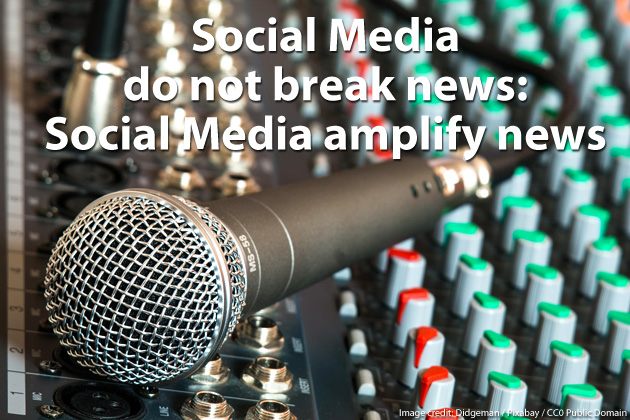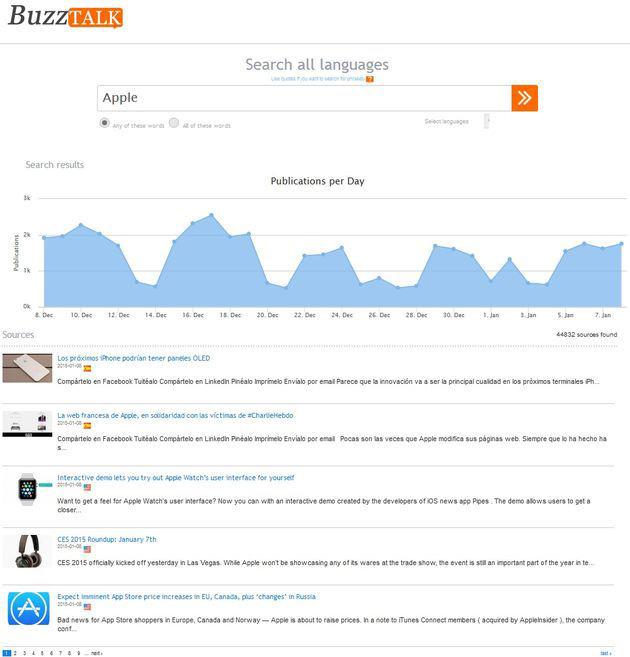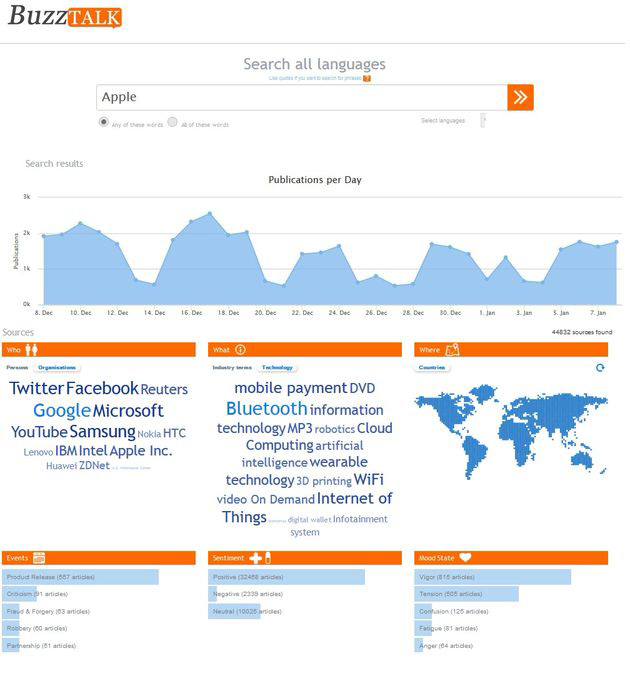Re member internet 1.0 when only companies and organizations could publish? Internet 2.0 changed that enabling everyone to not only interact with content, making it more relevant and lively, but also become a publisher themselves. And now we’re in internet 3.0 where we get the chance to analyze all of the content published to gain insight and empower decision making.
member internet 1.0 when only companies and organizations could publish? Internet 2.0 changed that enabling everyone to not only interact with content, making it more relevant and lively, but also become a publisher themselves. And now we’re in internet 3.0 where we get the chance to analyze all of the content published to gain insight and empower decision making.
This article shows you that the value of media and social media is largely untapped. Current media monitoring tools give you lists only show that something happened. Next generation monitoring tools move away from the real time webcare perspective. These are not tools for the PR department, but show influencers and decision making what has happened.
The publishing profession has been democratized
The way we are dealing with information has changed over the years. Not by choice, but because we have to. There is already so much information out there and every day new articles, video’s, podcasts and infographics are added to the tsunami of knowledge.
Not only are consumers publishing online – via various social media channels that require no budget and no technical skills – also companies are adopting the strategy what is known as ‘content marketing’ to get their message heard.
On top of that, Google is looking at social signals, fresh updates and links to your page to determine it’s rankings in the search result pages (well, these and at least 197 other factors). How are you going to get found organically if all you do is advertise?
And so it happened that every consumer and every company turned into a publisher, adding content to an already crowded blogosphere.
Social media as news distributor and amplifier tools
The word ‘social’ in social media refers to people connecting, relating and having conversations. However as 80% of all Facebook status updates and Twitter messages contain a link to an external website – usually an article but this can also be a video or graphic – these social media channels actually function as amplifiers of the news already out there.

Social media are important channels for distribution of the content generated by companies. Facebook and Twitter noticed this too and now use it to monetize their platforms. When you want your message (with a link to your website) to be seen by a lot of people, you now have to pay for it. Of course it’s not all black and white. It never is. Despite that organic reach of Facebook posts plummeted, your messages are shown to more people when these are relevant and engaging. When more people interact with your message, Facebook will show your post to more people.
What exactly are we monitoring when we monitor social media?
Social media inherently contain a lot of chatter, but within that chatter there’s also value. People express their opinion about pieces of content that are published elsewhere (there is just nog enough room, so people have to link to it). The actual and original publication being discussed lives on a news site, specialized blog site or scientific journal for instance. Social media updates are in essence ‘content pointers’ with a little bit of context added to them. So what does this mean for social media monitoring and value extraction?
If you really want to understand what is happening in your world you now know social media monitoring cannot be enough, by definition. You have to take the original publications into account and use Facebook and Twitter to find the sentiment or emotions that are expressed in the pointer-type status updates.
There is another dimension you can take into account to assess the value of the news without even looking at social media. A news update that is published by one news site often gets redistributed on other news sites when it’s of particular interest. One could argue that the number of republications correlates with the news value of the article. Therefor, to measure the impact of news you don’t need social media.
Expand your view from social media monitoring to media monitoring
We now know that in order to obtain a valid and complete view of what’s happening, including opinions and context, we need to gather complete articles from validated sources and categorize these extensively so they can be analyzed.
Such categories can range from company names (How often is my company mentioned in the media and in what way?), to competitor names (What are which media saying about my competitors?), to subjects that span a complete industry (What is happening in the dairy industry?) and much more.
But – in contrast to a 140 character Tweet – this is a lot of material to read. It’s impossible to grasp the essence of it all in a reasonably time frame. After all, we are all busy and need answers as quick as possible.
This is where monitoring tools come in handy. Most monitoring tools will tell you that something happened. They’ll show you when something happened and count the number of publications. These are in essence counters and list generators. Wherever you notice a spike in time, you’ll extract the publications from the list and start reading to find out what happened. Instead of a tweet as a pointer, you know have a monitoring tool that also functions as a pointer.
This solution is perfectly fine when you don’t have much data to process. Most companies don’t generate 50,000 publications in 12 weeks. However, when your research question isn’t about a local business but about a multinational such as IBM, Apple, Unilever or ING, you are in trouble. Also, list generating monitoring tools won’t help you beyond the pointing phase when you want to research a whole industry, such as the dairy industry, world-wide in various languages.
This is not to say (social) media monitoring tools are not valuable, because they are. For instance, you can use them to monitor tweets in real time for customer engagement and web care. When an unhappy client complains on Twitter, you want to respond fast and solve the problem.
Going from knowing THAT something happened to seeing WHAT did happen
When you need to perform research and analysis to support your business decisions, you don’t need the real time solution that web care like monitoring tools provide. There is a much more urgent factor than real-time tweets that you need.
For you it’s not enough to simply know THAT something happened. You want to know WHAT happened and without having to read all those publications.
Let’s for example take a look at Apple. By the way: a great media analysis tool will know the difference between an apple (as a fruit) and Apple (as a company). Questions you could ask such a media analysis tool are for instance: What happened lately with Apple? Were there any mergers and acquisitions? How is Apple related to sustainable business? Which persons are important when you research Apple? Which companies are mentioned whenever Apple is mentioned? Which industries are dominated by Apple? And why? Did they do any product launches and in which countries?
These are strategic questions every management team would want to know. They go beyond web care and customer engagement that is typically handled by the support- and communications department. Imagine gaining a head start when you can answer questions like these without reading hundreds of articles. Social media monitoring tools only show THAT something happened. They don’t tell us WHAT did happen.
Showing THAT something has happened:

Showing WHAT has happened:

As a decision maker you need systems that can provide you with answers to questions that matter. You know now why you’re having a hard time getting those answers out of social media monitoring tools. You need a media analysis tool that enables you to drill down into strategic matters such as innovations, marketing strategies, product launches, etc.
Do these advanced media analysis tools exist?
If you have come this far in the article chances are you’re in need of such a system. What you want is a computer that is capable of reading human language, preferably in multiple languages, and creating a summary or graphic that tells you the essence.
In order to do so the computer must recognize topics such as company names, industries, industry terms, person names, and much much more. Teaching a computer to read human language is not easy. Linguists and experts in artificial intelligence are working together world wide to enable this. One of these initiatives is Reuter’s OpenCalais and Buzztalk‘s OpenDover. Both are very powerful semantic tagging engines and can analyze – and tag – hundreds of written publications per second.
Key take-away
Media monitoring has evolved from simply listing publications in time and showing that something happened, to showing what has happened. Simple social media monitoring tools target web care teams and PR departments (as they look at individual tweets, read the whole tweet and want to respond fast on a tweet by tweet basis).
Next generation media analysis tools target management teams, business analysts and market researches and provide them with powerful tools for decision making. They are not just looking for information, but want to extract insights from the wealth of information out there.
Knowing that something happened is not an actionable insight.
Knowing what happened is.


Recent Comments